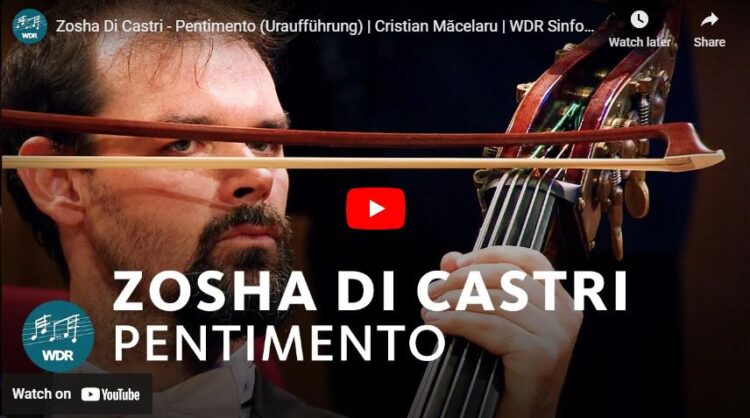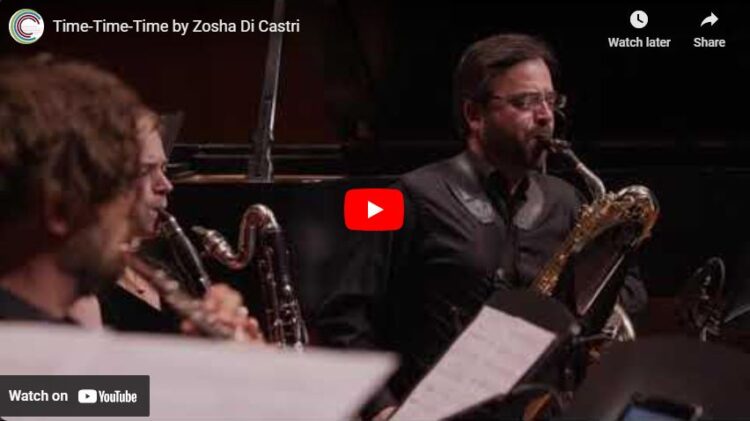When Zosha Di Castri was composing her piece Touch: Trace for conductor/percussionist Steve Schick and New York’s International Contemporary Ensemble, she was thinking not just of the group’s piano, cello, clarinet, and percussion as her instruments – but also of Schick’s body and movement as he performs.
“I wrote it for conducting percussionist, because Steve is also an amazing conductor, so gesture is really important in that piece,” she says. “It stemmed from a desire to work with him, seeing how he moves and interacts with people when he conducts, and having conversations with him about the concept, the idea of touch and points of contact and connection with the instrument, or between musicians, or between what’s happening on stage and the audience. That really inspired me.”
The Alberta-born, New York-based composer and pianist has an œuvre that’s awe-inspiring in its breadth, brilliance, and diversity. Di Castri has composed for large orchestras, string quartets, and vocal and instrumental soloists; incorporated electronics, video, dance and sculpture; and even created The Dream Feed, a podcast and performance series on musicians and motherhood. If there’s a thread that runs through her vastly different projects, it might be a focus on the characteristics of specific performers and instruments.
“Conceptually, it varies from project to project, but musically I’m interested in exploring the different textures or timbres or sound quality of the instruments I’m working with,” says Di Castri. “I find when I get to know the person I’m writing for, and the particular qualities of their playing, it motivates me. When I was writing for [vocalist] Barbara Hannigan for our project In the Half-Light, it was knowing the special quality of her voice, and having conversations with her about the text. That piece was tailored for what she can do with her voice, and I like that element. Of course it could be done by other people, but I think in the writing stage it’s helpful to have somebody in mind.”
Di Castri played piano from an early age, and later flute, oboe, and drums in a jazz band. “I always loved improvising at the piano, it was an outlet for me,” she recalls. “My mom heard about a young composer’s program with the Edmonton Symphony, and she encouraged me to do that, so I ended up having my first composition lessons in high school. That really put the bug in me. It was so exciting to hear my music come to life.”
Now Associate Professor of Music at Columbia University, Di Castri has received a JUNO nomination for the title track of her 2019 debut album, Tachitipo, and won several prestigious awards, including a Guggenheim Fellowship. She’s currently working on a collaboration with Montréal’s Totem Contemporain for a concert with Ensemble Paramirabo that will feature electronics and the Babel Table, an instrument invented by Totem’s Jean-François Laporte, that pushes compressed air through bowls, pipes, and membranes. “It’s a new experience for me, and I’m excited,” she says.
Not surprisingly, Di Castri’s writing process encompasses many methods. “I’ll hear ideas in my head, and sometimes I work them out on the piano,” she says. “Often I’ll use the computer to sort of mock up my ideas, and sometimes I’ll record voice memos when I’m walking to my job, or to pick up my kids. I do a lot of sketching too, and putting words on paper to try to clarify what I want.”
In 2019 Di Castri, then a fellow at the Institute for Ideas and Imagination (in Paris), was commissioned to write a piece for the first night of the BBC Proms concert series, to be performed by the BBC Symphony Orchestra and chorus at London’s Royal Albert Hall. It was the anniversary of the moon landing, and the theme was the moon.
“I didn’t have a flash of inspiration, so I talked to different scholars and artists and asked them to send me anything inspiring about the moon,” says Di Castri of her process for Long is the Journey, Short is the Memory. “I brought together texts from different periods and cultures – a fragment from Sappho, a poem from Giacomo Leopardi – and a writer at the institute, Xiaolu Guo, offered to contribute something. It was great to have this interweaving of different texts, and once the structure was there, it was fairly easy to write.”
From the large scale of Long is the Journey and Phonobellow, a project with David Adamcyk that involves percussionists improvising with a huge sound sculpture, to an exquisite solo piano piece like The Untellable Hour of Quiet, Di Castri’s work is thrillingly diverse and inventive, incorporating a panoply of instruments and collaborators, and always with the idea of movement.
“I’m thinking of gesture when I’m writing, in both the musical and visual sense,” she says. “What does it look like to see the performers playing? How are they moving, and how does that impact us listening and watching? Sometimes it starts with the visuals, and then moves toward sound. And some projects involve visual elements like sculpture or installation, people moving through space and transforming an object over time, and interacting with it. I think those are the key themes across my work.”

